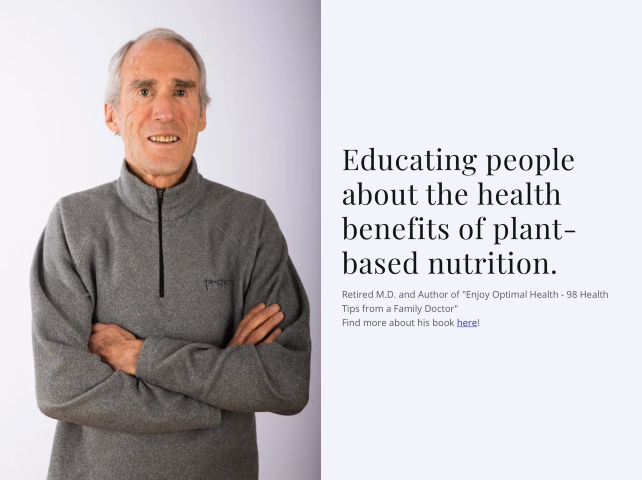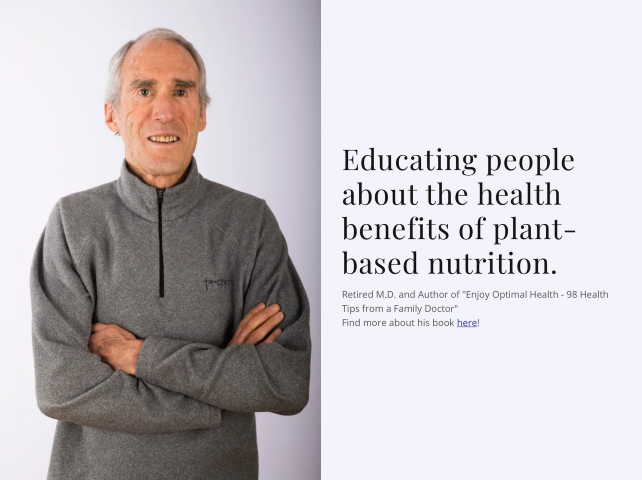Health column by Dr. Greg Feinsinger. Champion of Whole Food Plant Based Living and righteous person.
“The single greatest predictor of a healthy gut microbiome is the diversity of plants in one’s diet,” Will Bulsiewicz, M.D., MSCI, in “Fiber Fueled.”
This is another column in a series about the gut microbiome and health. An optimal microbiome contains a large diversity of health-promoting bacteria, and today we will discuss about how you can achieve and maintain that.
AVOID ANTIBIOTICS unless absolutely necessary. For example, 5 days of ciprofloxacin wipes out a third of gut bacteria, and although most species recover within 4 weeks, some are still absent after 6 months, and your microbiome may never completely recover. A course of clarithromycin or metronidazole can have harmful effects on the microbiome for 4 years.
AVOID PROCESSED FOOD, ARTIFICIAL SWEETENERS, AND OTHER FOOD ADDITIVES, all of which have a deleterious effects on gut bacteria.
AVOID ANIMAL PRODUCTS, or at least cut down to a minimum amount. Meat, dairy, seafood, and eggs all encourage growth of disease-promoting gut bacteria.
AVOID SUGAR AND TOO MUCH SALT (recommended maximum is 1500 mg. a day), which harm the microbiome.
PREBIOTICS refer to what healthy gut bacteria eat: fiber. Animals have bones that hold them up whereas plants have fiber that holds them up—only plants contain fiber. There is evidence that when humans were evolving people eat at least 100 grams of fiber daily and this is true in primitive societies today; the average American eats 15 grams. To optimize your gut microbiome eat a variety of vegetables daily including cruciferous veggies, legumes, fruit, whole grains, nuts, and seeds. People with the healthiest microbiomes eat at least 30 different plants a week.
PROBIOTICS are bacteria in supplements touted to improve the gut microbiome, and are controversial. Being supplements, they are poorly regulated, so you never know what you’re really getting. They have not been shown to help reestablish the gut microbiome during or following antibiotics, and as a matter of fact have been shown to delay normalization. Furthermore, they only last for a couple of days.
FERMENTED FOODS on the other hand are loaded with good bacteria and are useful for optimizing the microbiome. Dr. Bulsiewicz recommends that we all eat some daily, but they are especially useful for people with gastrointestinal issues and during and following a course of antibiotics. Examples are sauerkraut, kimchi, miso, tempeh, and Japanese natto, all of which have a high salt content, so eat small portions. Another fermented food is sourdough bread, which can be made without salt. Kombucha is a popular fermented drink, but look for a variety with a low sugar content. Kombucha is acidic and can erode tooth enamel, so dilute it with water. Yogurt is a fermented dairy product, and if you avoid dairy Kite Hill yogurt is made from almond milk--only buy the plain because the flavored varieties contain a lot of sugar.
POSTBIOTICS refer to the health-promoting substances made by an optimal gut microbiome—such as short chain fatty acids.
EXERCISE results in a 40 percent increase in healthy gut microbes. Adequate sleep and stress reduction also support a healthy microbiome.
EAT AT REGULAR TIMES: Remember, you aren’t just eating for one, but for several trillion bacteria as well. What you eat is what they eat. They are on a regular, circadian rhythm and the good bacteria thrive best when you eat at 3 regular meals a day, and don’t skip meals.



